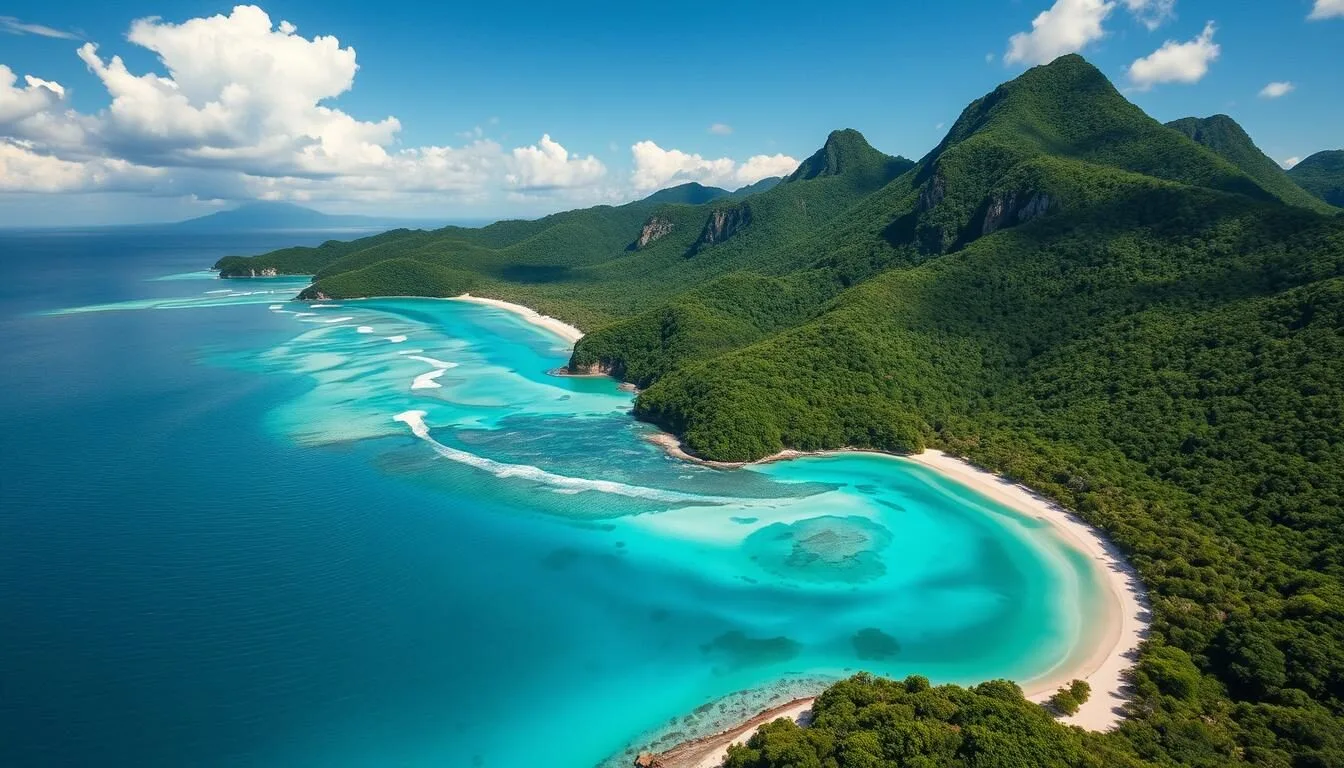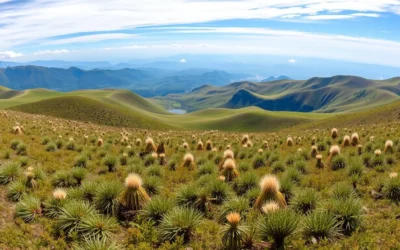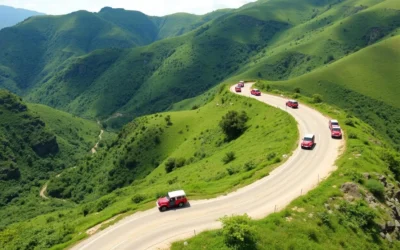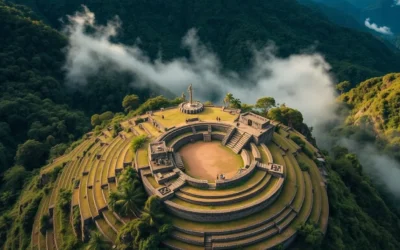Did you know Tayrona National Park shelters over 300 bird species and ancient archaeological sites within its 150 square kilometers of pristine jungle and coastline? This spectacular natural reserve, where the Sierra Nevada mountains dramatically meet the Caribbean Sea, is not only Colombia’s second most visited national park but also one of UNESCO’s five most important national parks worldwide.
Nestled along Colombia’s Caribbean coast, Tayrona National Park (Parque Nacional Natural Tayrona) is a breathtaking blend of biodiversity, cultural heritage, and stunning landscapes. This coastal paradise offers travelers a unique opportunity to experience pristine beaches, lush rainforests, and the rich indigenous history of the region—all within one spectacular setting.
In this comprehensive guide, we’ll walk you through everything you need to know to plan an unforgettable visit to Tayrona National Park. From practical tips on getting there and finding the perfect place to stay, to discovering the most beautiful beaches and hidden gems within the park, we’ve got you covered.
Ready to explore Tayrona National Park?
Start planning your Colombian adventure today!
Planning Your Journey to Tayrona National Park
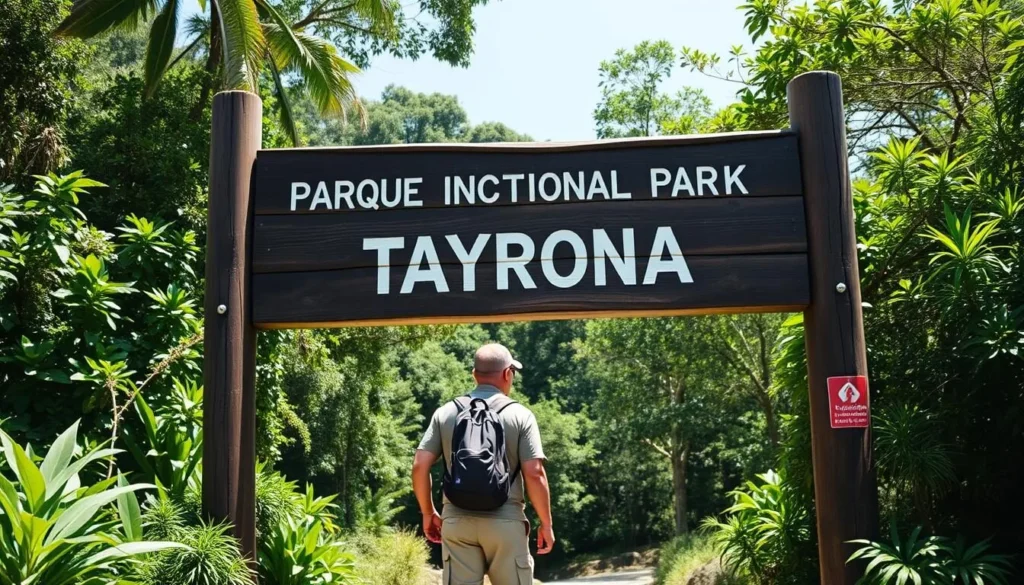
Before setting off on your Tayrona adventure, it’s essential to understand the park’s regulations, entry requirements, and seasonal considerations. Proper planning will ensure you make the most of your visit to this natural paradise.
Park Entry Requirements
Visiting Tayrona National Park requires some preparation. All visitors must purchase an entrance ticket, which varies in price depending on the season:
- Foreign visitors: 73,500 COP (low season) / 87,000 COP (high season)
- Mandatory insurance: 6,000 COP per person per day
- Children under 5 and Colombians over 65: Free entry
You’ll need to present your passport at the entrance, and some visitors may be asked to show proof of yellow fever vaccination (though this isn’t consistently enforced). It’s worth getting vaccinated before your trip as a precaution.
Important: Tayrona National Park closes completely during three periods each year to allow the ecosystem to recover and for indigenous communities to perform traditional ceremonies:
- February 1-15
- June 1-15
- October 19 – November 2
Plan your visit accordingly to avoid disappointment!
Park Hours and Best Time to Visit
The park is open from 8:00 am to 5:00 pm during low season and 7:00 am to 5:00 pm during high season. Last entry is at 4:00 pm at the El Zaíno entrance and 2:00 pm at the Calabazo entrance.
For the best experience, consider these seasonal factors:
High Season (December-January, June-July)
- More crowded, especially on weekends
- Drier weather with less rain
- Higher prices for accommodation
- Earlier park opening hours (7:00 am)
Low Season (Rest of the year)
- Fewer visitors, more peaceful experience
- Higher chance of rain, especially September-November
- More availability for accommodation
- Better wildlife spotting opportunities
The ideal times to visit are March or mid-November when the park is quietest, though you might encounter some humidity and occasional rain. Weekdays are always less crowded than weekends, regardless of the season.
Ready to secure your accommodation?
Book early to ensure availability, especially during high season!
How to Get to Tayrona National Park
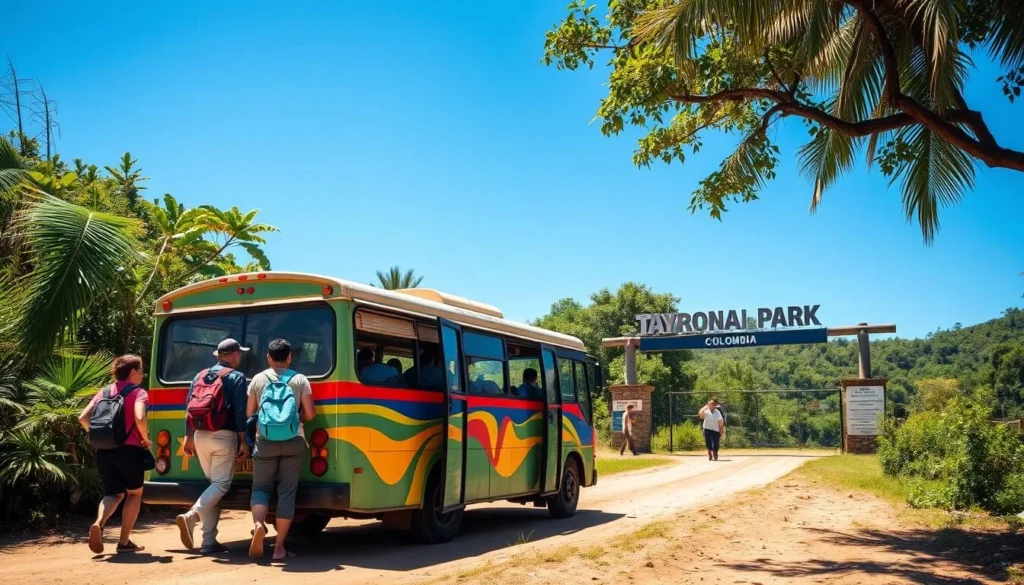
Tayrona National Park is easily accessible from several nearby cities, with Santa Marta being the most common starting point. Here are the best ways to reach the park:
From Santa Marta to Tayrona
Santa Marta serves as the main gateway to Tayrona National Park, with several transportation options available:
By Public Bus
The most economical option is to take a public bus from Santa Marta’s city center. Buses depart every 30 minutes from the corner of Calle 11 & Carrera 9 near the Central Market (Mercado Público).
- Cost: Approximately 10,000 COP one-way
- Duration: 45-60 minutes
- First bus: Around 6:00 am
Simply tell the driver you’re going to “Tayrona” or “El Zaíno” (the main park entrance).
From Taganga to Tayrona
If you’re staying in the nearby fishing village of Taganga, you have a unique option:
By Boat
Daily speedboats depart from Taganga beach around 9:30 am and take you directly to Cabo San Juan beach inside the park, bypassing the main entrance and hiking trail.
- Cost: Approximately 50,000 COP one-way
- Duration: 45-50 minutes
- Return boats: Around 4:00 pm from Cabo San Juan
Note: The sea can be quite rough between October and March, so be prepared to get wet and protect your belongings with waterproof bags.
From Other Locations
From Palomino
If you’re coming from the beach town of Palomino, catch a bus heading toward Santa Marta and ask to be dropped at the Tayrona entrance.
- Cost: Around 8,000 COP
- Duration: 45 minutes
From Cartagena
From Cartagena, take a direct bus to Santa Marta with companies like MarSol or Berlinas, then connect to Tayrona using one of the methods above.
- Cost: 50,000-70,000 COP to Santa Marta
- Duration: 4-5 hours
Pro Tip: If you’re only visiting Tayrona for a day or two, consider leaving your large backpack or suitcase at your hostel in Santa Marta. Most accommodations offer free luggage storage, allowing you to travel light with just essentials for your park visit.
Park Entrances: Choosing Your Gateway
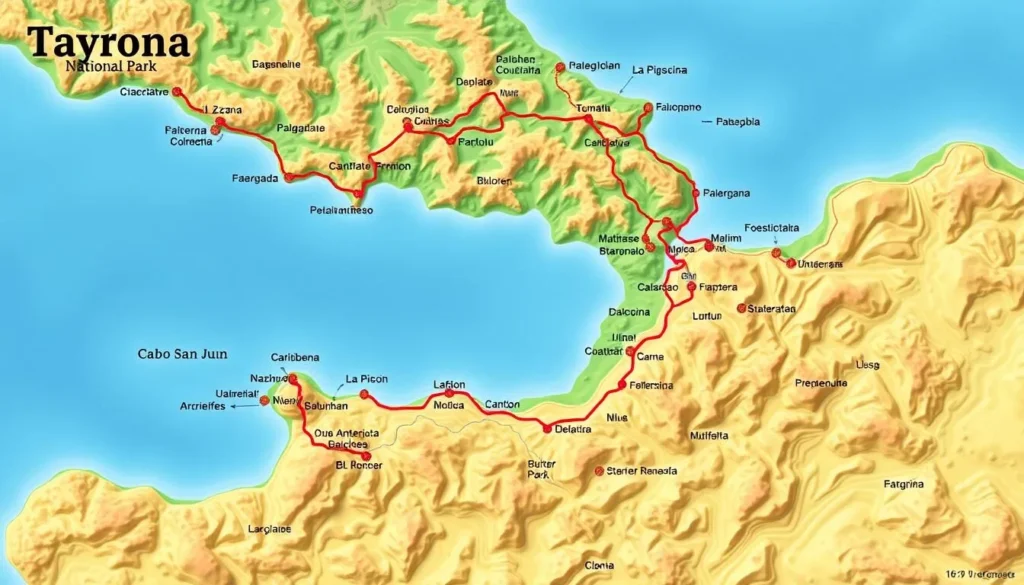
Tayrona National Park has four main entrances, each offering access to different areas of the park. Your choice of entrance will significantly impact your experience:
El Zaíno Entrance (Main Entrance)
This is the primary and most popular entrance to Tayrona National Park, located about an hour from Santa Marta. Most visitors enter through El Zaíno because:
- It provides the most direct access to the park’s most famous beaches
- It has the most developed facilities, including information centers
- Public transportation regularly services this entrance
- The trail from here is well-marked and maintained
After purchasing your ticket, you can either walk 4km to the trailhead or take a shuttle bus for 5,000 COP (highly recommended to save energy for the actual park trails).
Calabazo Entrance
This secondary entrance is less crowded but requires more hiking to reach the main beaches:
- Located about 10 minutes before El Zaíno when coming from Santa Marta
- Offers a more adventurous 3.5-hour hike through dense forest
- Passes by El Pueblito, an archaeological site with Tayrona ruins
- Provides easier access to Playa Brava, one of the park’s most secluded beaches
This entrance is ideal for hikers who enjoy a challenge and want to avoid crowds.
Other Entrances
Cabo San Juan (By Boat)
Entering via speedboat from Taganga lets you skip the hiking and arrive directly at Cabo San Juan beach. You’ll still need to register and pay the entrance fee upon arrival.
Palangana Entrance
This less-used entrance provides access to different beaches like Playa Cristal, Neguanje, and Gairaca. It’s about 20 minutes from Santa Marta but has limited public transportation options.
Entrance Decision Guide: Choose El Zaíno if you want the classic Tayrona experience with access to the most popular beaches. Opt for Calabazo if you’re an avid hiker seeking a more adventurous and less crowded route. Select the boat entrance if you want to maximize beach time and minimize hiking.
The Best Beaches in Tayrona National Park
Tayrona’s beaches are the crown jewels of the park, offering a stunning variety of coastal landscapes. From swimmable coves to wild, untamed stretches of sand, here’s your guide to the park’s most beautiful beaches:
Cabo San Juan
The most famous and photographed beach in Tayrona, Cabo San Juan features a distinctive rock outcrop connecting two beautiful bays. This is the social hub of the park and offers:
- Safe swimming areas with lifeguard supervision
- The iconic hammock hut perched on rocks overlooking the beach
- Camping facilities and basic restaurants
- Picture-perfect palm-fringed shoreline
While it’s undeniably beautiful, be prepared for crowds, especially during midday when day-trippers arrive. Early morning and late afternoon offer more peaceful experiences.
La Piscina
Located between Arrecifes and Cabo San Juan, La Piscina (The Pool) is named for its natural rock barrier that creates a calm swimming area protected from strong currents:
- One of the safest swimming spots in the park
- Excellent snorkeling opportunities with colorful fish
- Less crowded than Cabo San Juan
- Beautiful crescent-shaped beach with clear waters
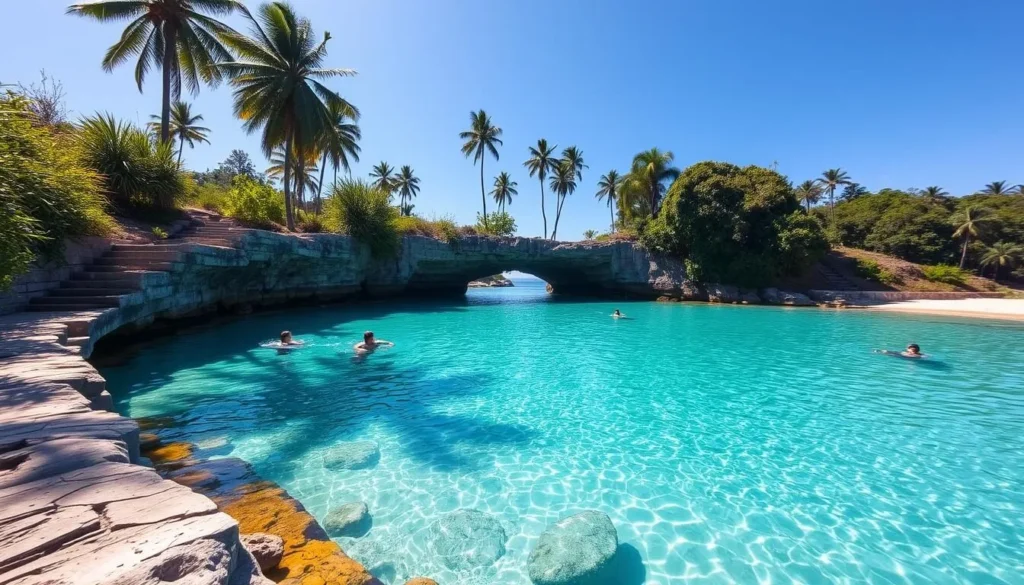
Arrecifes
This long, wild stretch of beach is one of the first you’ll encounter on the trail from El Zaíno. While swimming is strictly prohibited due to dangerous currents, Arrecifes offers:
- Dramatic scenery with powerful waves crashing against the shore
- Less crowded atmosphere than beaches further along the trail
- Nearby camping options with better facilities than Cabo San Juan
- A beautiful lagoon (but beware of crocodiles!)
Safety Warning: Many beaches in Tayrona have dangerous rip currents and swimming is prohibited. Always respect the warning signs and only swim in designated safe areas like La Piscina and Cabo San Juan. Hundreds of people have lost their lives ignoring these warnings.
Other Notable Beaches
Playa Brava
A secluded beach accessible via a challenging hike from Calabazo. No swimming allowed, but worth the trek for its wild beauty and fewer visitors.
Playa Cristal
Accessible from the Palangana entrance, this beach limits visitors to 300 per day. Known for its crystal-clear waters perfect for snorkeling.
Playa Nudista
A 15-minute walk from Cabo San Juan, this clothing-optional beach offers more seclusion and tranquility than its famous neighbor.
Experience Tayrona’s breathtaking beaches
Book a guided tour to discover the best spots with local expertise
Explore Tours
Hiking Trails and Wildlife
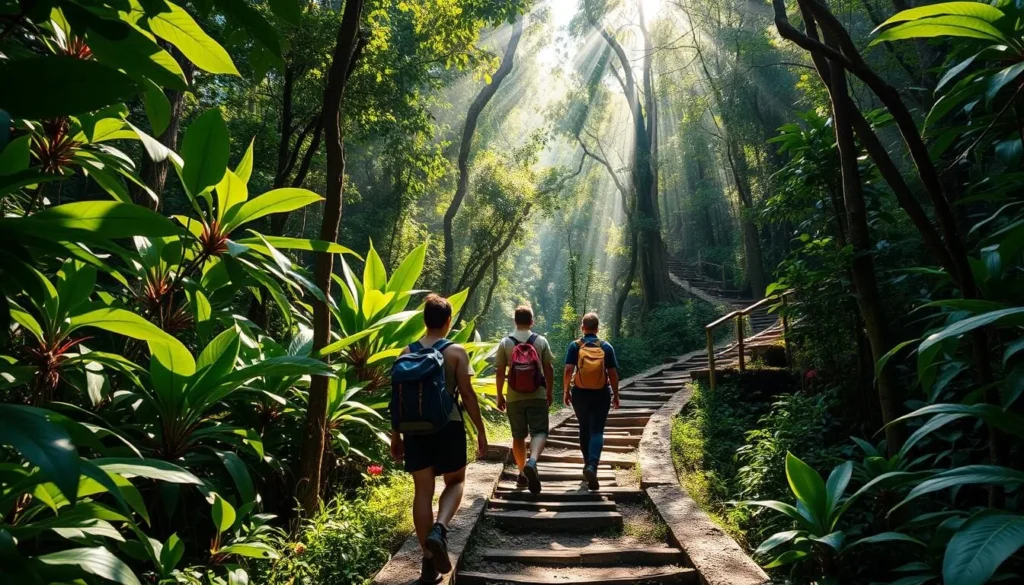
Tayrona National Park offers more than just beaches—its network of hiking trails takes you through diverse ecosystems teeming with wildlife. From easy coastal walks to more challenging forest treks, there’s something for every level of hiker.
Main Hiking Routes
El Zaíno to Cabo San Juan
The most popular hiking route in the park takes you from the main entrance to the famous Cabo San Juan beach:
- Distance: Approximately 4-5 km (after the shuttle drop-off)
- Duration: 2-3 hours one-way at a moderate pace
- Difficulty: Moderate with some uneven terrain
- Highlights: Passes by Arrecifes and La Piscina beaches
The trail alternates between shaded forest paths, wooden boardwalks, and stretches along the coastline. Wear proper footwear as parts can be muddy or slippery.
Nine Stones Trail (9 Piedras)
This lesser-known trail near Cañaveral beach follows the eastern cliffs of the park:
- Distance: 1.5 km loop
- Duration: 1-1.5 hours
- Difficulty: Easy to moderate
- Highlights: Nine ancient stones with astronomical significance, panoramic views, possible alligator sightings in the lagoon
This trail is significant to the indigenous Kogui people and offers excellent views of the coastline.
Calabazo to Cabo San Juan via Pueblito
A more challenging route for experienced hikers:
- Distance: Approximately 10 km
- Duration: 3.5-4 hours one-way
- Difficulty: Challenging with steep sections
- Highlights: Passes through El Pueblito archaeological site, less crowded, better wildlife spotting
This trail offers a more authentic jungle experience and takes you through the archaeological site of El Pueblito, with stone terraces and circular house foundations built by the Tayrona people over 500 years ago.
Wildlife Spotting
Tayrona National Park is home to an incredible diversity of wildlife. Keep your eyes peeled for:
Mammals
- Howler monkeys (listen for their distinctive calls)
- Cotton-top tamarins (one of the world’s rarest monkeys)
- Sloths (look up in the trees for these slow-moving creatures)
- Agoutis and other small mammals
Birds
- Over 300 species including toucans and parrots
- Magnificent frigatebirds along the coast
- Hummingbirds in flowering areas
- Various herons and egrets near water bodies

Best Time for Wildlife: Early morning (6-9 am) and late afternoon (4-6 pm) offer the best opportunities for wildlife spotting. The area between the park entrance and the trailhead is particularly good for bird watching.
Where to Stay in Tayrona National Park
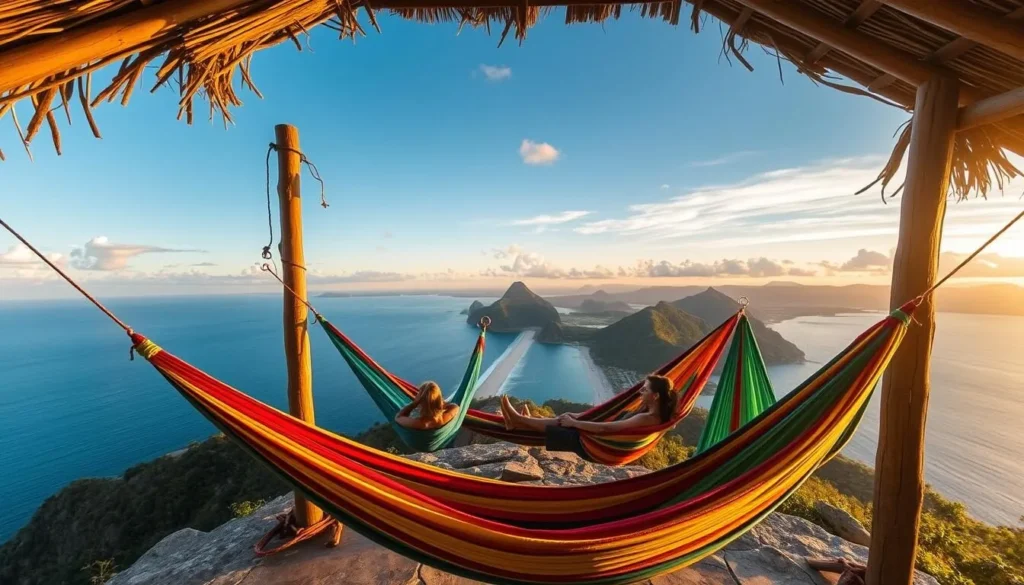
Staying overnight in Tayrona allows you to experience the park when day-trippers have left, offering magical sunrises and a more peaceful atmosphere. Accommodation options range from basic hammocks to more comfortable eco-lodges.
Inside the Park
Cabo San Juan Campsite
The most popular accommodation option within the park:
- Hammocks: 50,000 COP (regular) / 60,000 COP (viewpoint hammocks)
- Tent rental: 40,000 COP per person
- Bring your own tent: 30,000 COP per person
- Private cabins: 200,000 COP for two people (limited availability)
Facilities include basic bathrooms, cold showers, a restaurant, and lockers for valuables. The site often fills up quickly, especially during high season.
Arrecifes Campsite
A less crowded alternative with better facilities:
- Hammocks: 15,000-30,000 COP
- Tent rental: 40,000-60,000 COP for two people
- Cabins: Starting at 80,000 COP
Located near Arrecifes beach, this campsite offers more space and modern facilities than Cabo San Juan, but you’ll need to walk 20-60 minutes to reach the swimming beaches.
Ecohabs Tayrona
For those seeking luxury within the park:
- Luxurious thatched-roof bungalows
- Private bathrooms with hot water
- Restaurant and bar
- Located near Cañaveral beach
These upscale accommodations offer comfort in a natural setting but come with a premium price tag (starting at around $200-300 USD per night).
Near the Park
If you prefer more comfortable accommodations or are on a day trip, consider staying just outside the park:
Costeño Beach
A relaxed beach area with several hostels and eco-lodges. Just a 15-minute moto-taxi ride to the park entrance, making it perfect for early morning visits.
Santa Marta
The main city in the region offers a wide range of accommodations from budget hostels to luxury hotels. A good base if you’re planning a day trip to Tayrona.
Palomino
A laid-back beach town about 45 minutes from Tayrona, popular with backpackers and offering a range of budget-friendly options.
Booking Tip: During high season (December-January, June-July), accommodations inside the park fill up quickly. If staying at Cabo San Juan, you can now reserve hammocks and tents in advance via WhatsApp (+57 311 2589907). For other campsites, arrive early in the morning to secure your spot.
Practical Tips for Visiting Tayrona

What to Pack
Packing smartly for Tayrona is essential for a comfortable experience. Here’s what you should bring:
Essential Items
- Passport (required for entry)
- Cash (no ATMs in the park)
- Water bottle (at least 2 liters per day)
- Sunscreen and hat
- Insect repellent
- Swimwear and quick-dry towel
- Comfortable walking shoes/hiking sandals
- Flashlight or headlamp (essential for nights)
- Basic toiletries and toilet paper
If Staying Overnight
- Light, long-sleeved clothing for evenings
- Warmer layer for night (especially for hammocks)
- Sleeping bag liner or light blanket
- Padlock for lockers
- Portable charger/power bank
- Snacks and food supplies
- Waterproof bag for electronics
- Rain jacket (during rainy season)
Prohibited Items: The following items are not allowed in Tayrona National Park:
- Alcohol and drugs
- Plastic bags
- Drones
- Musical instruments
- Surfboards
Bags may be searched at the entrance, so leave prohibited items behind.
Food and Water
There are restaurants at the main campsites (Arrecifes, Cabo San Juan), but they can be expensive and have limited hours:
- Breakfast: 7,000-15,000 COP
- Lunch/Dinner: 18,000-40,000 COP
- Beer: 7,000 COP
- Water (1.5L): 6,000 COP
To save money, bring your own food supplies from Santa Marta. Non-perishable items like bread, canned tuna, fruits, nuts, and energy bars are good options. There are small shops at the entrance and campsites selling basic supplies, but at higher prices.
Money Matters
Financial preparation is crucial for your Tayrona visit:
- Bring enough cash for your entire stay (no ATMs in the park)
- Budget approximately 200,000-250,000 COP per person per day for a comfortable experience (including entrance, accommodation, food, and transportation)
- Keep your money secure in a money belt or pouch
- Some facilities accept credit cards, but don’t rely on this
Luggage Storage: If you’re only visiting for a day or two, leave your large backpack at your hostel in Santa Marta or at storage facilities at the park entrance (10,000 COP per day). Travel light with just essentials in a daypack.
Cultural Significance and Indigenous Heritage
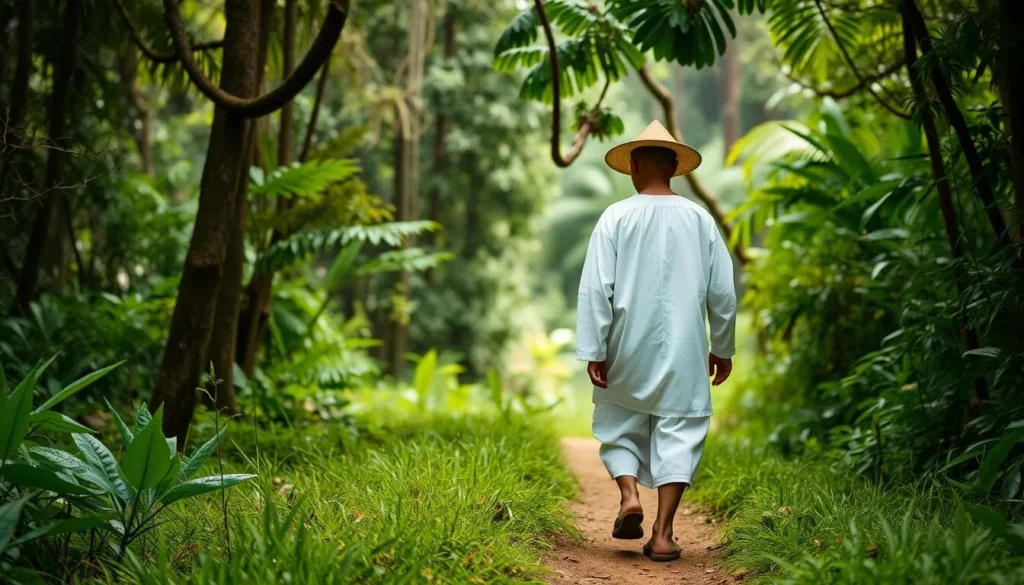
Tayrona National Park isn’t just a natural wonder—it’s a culturally significant area with deep indigenous roots. The park and surrounding Sierra Nevada mountains are the ancestral home of four indigenous groups: the Kogi, Arhuaco, Wiwa, and Kankuamo, who are direct descendants of the ancient Tairona civilization.
Indigenous Communities
The indigenous communities, particularly the Kogi (recognizable by their distinctive all-white clothing), consider Tayrona a sacred site. They serve as the ecological and spiritual guardians of the land, maintaining ancient traditions and knowledge:
- The park closures in February, June, and October-November allow these communities to perform traditional cleansing ceremonies
- Many sacred sites within the park hold special significance to these communities
- The indigenous groups practice sustainable living and have valuable ecological knowledge
Archaeological Sites
Tayrona contains several archaeological sites that offer glimpses into the region’s pre-Columbian past:
El Pueblito (Chairama)
A small archaeological site accessible via a hiking trail from Cabo San Juan or the Calabazo entrance:
- Ancient stone terraces and circular foundations
- Built by the Tairona people over 500 years ago
- Considered a smaller version of the famous Lost City (Ciudad Perdida)
Note: As of recent years, El Pueblito may be closed to visitors as it is considered a sacred site. Check current status before planning your visit.
Respectful Visitation: When encountering indigenous people or archaeological sites, remember you are a guest in their ancestral territory. Maintain a respectful distance, ask before taking photographs, and follow any guidelines provided by park authorities.
Explore Colombia’s rich indigenous heritage
Discover guided cultural tours with local experts
Book Cultural Tours
Safety Information
While Tayrona National Park is generally safe for visitors, there are several important safety considerations to keep in mind:
Water Safety
The most critical safety concern in Tayrona is water safety:
- Many beaches have dangerous rip currents and strong undertows
- Only swim at designated safe beaches (La Piscina and Cabo San Juan)
- Red flags indicate dangerous swimming conditions—never ignore them
- Hundreds of people have died ignoring swimming warnings
Health Precautions
Sun Protection
- The Caribbean sun is intense—wear high SPF sunscreen
- Reapply sunscreen regularly, especially after swimming
- Wear a hat and sunglasses
- Seek shade during peak sun hours (11am-3pm)
Insect Protection
- Apply insect repellent, especially in evenings
- Consider treating clothes with permethrin
- Sleep under mosquito nets when available
- Wear long sleeves and pants in the evening
Trail Safety
When hiking in Tayrona, follow these guidelines:
- Stay on marked trails at all times
- Wear appropriate footwear (not flip-flops)
- Carry sufficient water to prevent dehydration
- Hike with a companion when possible
- Start long hikes early in the day
Emergency Information: Park rangers are stationed throughout Tayrona. In case of emergency, seek their assistance immediately. The mandatory insurance you purchase with your entrance ticket covers emergency evacuation if needed.
Sample Itineraries
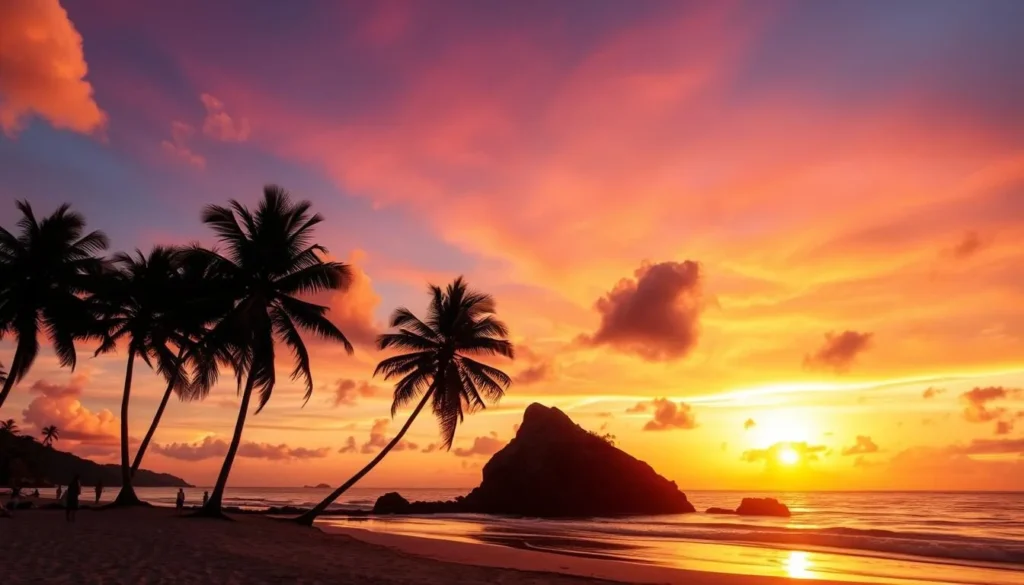
To help you plan your visit, here are some suggested itineraries based on the length of your stay:
One-Day Visit
While a day trip isn’t ideal given the entrance fee and travel time, it’s possible if you’re short on time:
- Arrive at El Zaíno entrance by 8:00 am
- Take the shuttle to the trailhead
- Hike to Arrecifes (1 hour)
- Continue to La Piscina for swimming and snorkeling (30 minutes)
- Reach Cabo San Juan for lunch and beach time (30 minutes)
- Begin return journey by 2:00 pm
- Exit the park by 5:00 pm
This is a rushed schedule but allows you to see the highlights.
Two-Day Visit (Recommended)
The ideal duration for most visitors:
Day 1:
- Arrive at El Zaíno entrance by 8:00 am
- Take the shuttle to the trailhead
- Hike to Arrecifes, taking time to enjoy the scenery
- Continue to La Piscina for swimming
- Reach Cabo San Juan by early afternoon
- Secure accommodation (hammock or tent)
- Relax on the beach and enjoy sunset
Day 2:
- Wake up early for sunrise
- Morning swim when beaches are empty
- Optional hike to Playa Nudista or Pueblito
- Pack up and begin return journey after lunch
- Exit the park by 5:00 pm
Three-Day Visit
For those who want a more relaxed pace and to explore more of the park:
Day 1: Same as two-day itinerary
Day 2:
- Morning hike to Pueblito archaeological site
- Return to Cabo San Juan for afternoon relaxation
- Explore nearby beaches
Day 3:
- Early morning beach time
- Optional snorkeling at La Piscina
- Begin return journey after lunch
- Exit via the same route or consider boat to Taganga
Timing Tip: The most magical times in Tayrona are early mornings and late afternoons when day-trippers are absent. If staying overnight, make the most of these peaceful periods.
Frequently Asked Questions
Do I need a yellow fever vaccination to enter Tayrona National Park?
While officially required, the yellow fever vaccination certificate is not consistently checked at the entrance. However, getting vaccinated is recommended for your own health protection and to prevent spreading the disease to local communities. Some visitors have reported being asked for proof of vaccination, so it’s better to be prepared.
Can I visit Tayrona National Park during COVID-19?
Yes, Tayrona National Park is open to visitors, though some health protocols may still be in place. These might include temperature checks, hand sanitization stations, and mask requirements in certain areas. Check the official park website for the most current information before your visit.
Is it safe to visit Tayrona National Park?
Tayrona is generally safe for tourists, with a significant park ranger presence. The main safety concerns are swimming in dangerous areas (only swim at designated beaches), dehydration, and sun exposure. As with any tourist destination, be aware of your belongings, especially in crowded areas.
Can I book accommodation in Tayrona in advance?
For Cabo San Juan, you can now reserve hammocks and tents via WhatsApp (+57 311 2589907). Ecohabs and some other accommodations can be booked online. For most campsites, it’s still first-come, first-served, so arriving early is recommended, especially during high season.
What’s the best time of year to visit Tayrona?
The driest months are December through March, but this is also high season with more crowds. For fewer people, consider visiting in March or mid-November, though you might encounter some rain. Avoid Colombian holiday periods and remember the park closes completely during three periods throughout the year.
How difficult is the hiking in Tayrona?
The main trail from El Zaíno to Cabo San Juan is moderately difficult but manageable for most people with average fitness. The terrain includes uneven paths, some muddy sections, and wooden walkways. The heat and humidity make it more challenging, so pace yourself and bring plenty of water.
Why Tayrona National Park Should Be on Your Colombia Itinerary
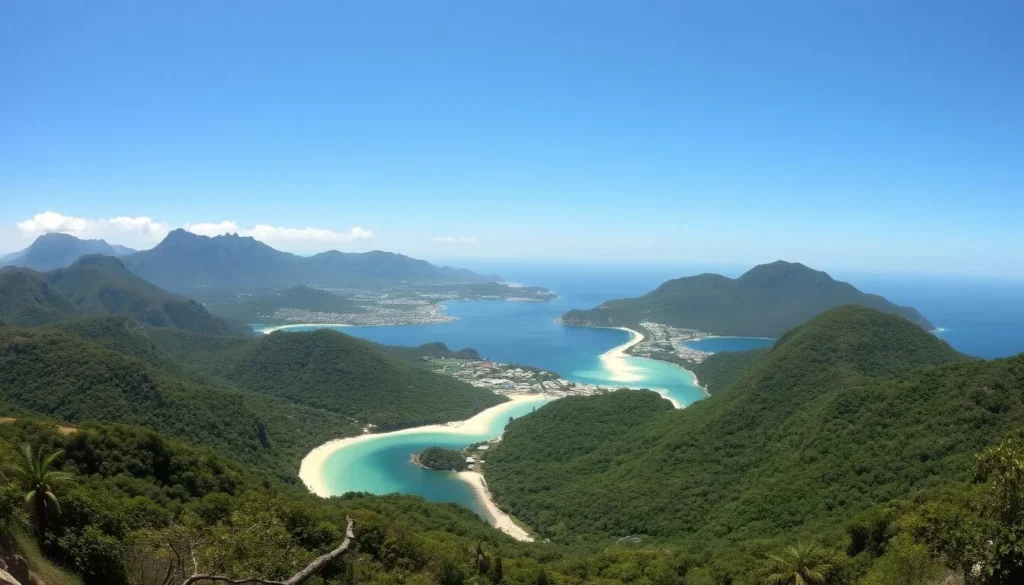
Tayrona National Park represents Colombia at its most magnificent—a place where lush mountains cascade into the turquoise Caribbean Sea, creating a paradise of pristine beaches, vibrant jungles, and rich biodiversity. Despite its growing popularity, Tayrona still offers moments of tranquility and connection with nature that are increasingly rare in our busy world.
From the thrill of spotting colorful wildlife on jungle trails to the simple pleasure of swinging in a hammock with the sound of waves crashing nearby, Tayrona offers experiences that will stay with you long after your visit. The park’s sacred significance to indigenous communities adds another dimension to your journey, reminding us of the deep cultural heritage that makes Colombia so special.
Yes, visiting requires some planning and preparation. Yes, you might have to forgo some comforts for a night or two. But the reward—waking up to a sunrise over the Caribbean from your hammock, swimming in crystal-clear waters surrounded by jungle-covered mountains, and experiencing one of South America’s most spectacular coastal landscapes—is absolutely worth it.
Tayrona National Park isn’t just a destination; it’s an experience that captures the essence of Colombia’s natural beauty and cultural richness. Add it to your itinerary, and discover why this magical place continues to captivate travelers from around the world.
Ready to experience Tayrona National Park?
Start planning your Colombian adventure today!
The above is subject to change.
Check back often to TRAVEL.COM for the latest travel tips and deals.
